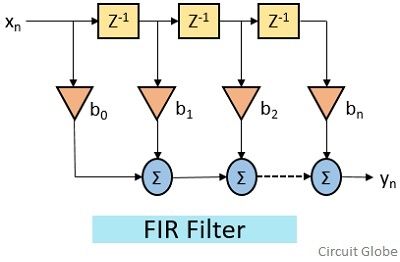FIR VS IIR Filter
Both FIR and IIR are the two major classifications of digital filters used for signal filtration. The crucial difference between FIR and IIR filters is that the FIR filter provides an impulse response of a finite period. As against IIR is a type of filter that generates impulse response of infinite duration for a dynamic system.
Here we are talking about finite and infinite impulse response. But what is impulse response?
So, basically, we know that the response of a system defines the behavior of the system according to the variation in the external parameters associated with the system. Thus impulse response of a system is defined as the outcome or response achieved when the system is provided with input signals (generally known as an impulse).
More simply we can say that impulse response provides the reaction of a dynamic system with respect to an independent variable (say time).In this article, we will discuss the major differentiating factors between FIR and IIR filters.
Content: FIR Vs IIR Filter
|
Basis for Comparison |
FIR Filter |
IIR Filter |
|
Stands for |
Finite Impluse Response |
Infinite Impulse Response |
|
Nature |
Non-recursive |
Recursive |
|
Computational Efficiency |
Less |
Comparatively more |
|
Usage |
Difficult |
Quite easy |
|
Feedback |
Absent |
Present |
|
Stability |
More |
Less |
|
Requirement to generate current output |
Present and past samples of input. |
Present and past samples of input along with past output. |
|
Delay offered |
High |
Comparatively lower |
|
Transfer function |
Only zeros are present. |
Both poles and zeros are present. |
|
Memory requirement |
More |
Less |
|
Sensitivity |
Less |
Comparatively more |
|
Resolution offered at low frequencies |
Less |
More |
|
Controllability |
Easy |
Quite Difficult |
Definition of FIR filter
A type of digital filter that generates a finite impulse response of a dynamic system is known as FIR filters. More simply, we can say, here the impulse response provided by the filter is of finite duration. In FIR filters the response gets fixed to zero in a finite period of time thus it is named so. In the case of FIR filters, the nth order filter generates n+1 samples before getting fixed to 0.
The figure below represents a discrete form of FIR filter:

In FIR filters, feedback is not present thus these operate on only present and past input values. Hence the output is the summation of a finite quantity of finite samples of input values. So, these are highly stable. The generalized equation for FIR filter is given as:

:N is the length of the filter.
FIR filters are used with systems having 0 response.
Definition of IIR filter
The type of digital filter that is designed to generate infinite impulse response of a dynamic system is known as the IIR filter. As an internal feedback mechanism is present in these filters thus the filter operates for an indefinite period of time. IIR filters are used by the systems that generate an infinite response.
The filter below represents the structure of the IIR filter:

IIR filter operates in a way that not only the present and past inputs but the past output sample is also taken into consideration. The equation in general form for IIR filter is given as:
As these filters support the recursive operation. Thus it never allows its response to settle to 0 for the applied impulse. The memory requirement and computational time enhance the efficiency of the IIR filters. Also, it is quite easy to convert an analog filter into a digital IIR filter.
Key Differences between FIR and IIR Filter
- FIR filter generates an output of a dynamic system using the samples of present and past input values. While an IIR filter uses present and past input values along with the past output value to generate the present output.
- FIR filters do not use feedback circuitry, while IIR filters make use of feedback loop in order to provide previous output in conjunction with current input.
- FIR filters support linear phase filtering, however, IIR filters do not support linear phase filtering.
- As FIR filters have more strength in comparison to IIR filters thus these offer more flexible operation than the IIR filters.
- The transfer function of the system having an FIR filter contains only zeros. While in the case of IIR filters the transfer function contains both poles and zeros.
- FIR filters show non-recursive behaviour. But IIR filters show recursive behaviour.
- Due to the absence of the feedback loop, the implementation of FIR filters in a system is quite easy in comparison to IIR filters in which a feedback loop is present.
- The delay in providing a response in case of FIR filters is more than that of IIR filter.
- FIR filters are more stable as here the present output does not hold any relationship with the previous output. But IIR filters are less stable as it makes use of previous output samples as well.
- FIR filters need greater processing power in comparison to IIR filters.
- The way in which a filter operates decides its computational efficiency. The computational efficiency of FIR filters is quite less than IIR filters.
What can FIR do?
FIR filter: frequency response and phase can be adjusted separately
FIR filters can arbitrarily change phase without changing frequency response
FIR filters can arbitrarily change the frequency response without changing the phase
1. Using FIR can optimize the phase
For example, when combining different models of audio systems, phase calibration can be used to make them overlap in the same phase, avoiding sound cancellation caused by different initial phases of different models.

2.FIR can be used for frequency response correction and frequency division (during research and development)
It is possible to perform frequency response correction and frequency division effectively during research and development.
3.By utilizing FIR, a certain point can have good frequency response and phase
Let a certain listening point, such as a recording studio, achieve good frequency response and phase at this point. But only for a certain point in space.
4.Measure the average of multiple points and optimize the average curve using FIR
Frequency response can be measured at different locations and processed evenly. It is recommended to have at least 3 measurement points, and then only focus on frequency response processing on the average curve to make the average frequency response and power response in the listening environment smoother.

5. Optimize speaker directionality using FIR
Like some software, FIR design functions can be used to achieve uniformity in the audience area and consistency in front and rear frequencies.

Conclusion
So, from this discussion, we can say that due to the various advantages associated with FIR filters these are more preferred over IIR filters. FIR filters are mainly used in bandpass and bandstop filtering applications. While low pass and anti-aliasing filtering applications require IIR digital filters.
Sinbosen DSP D-Series Amplifier with FIR function, Powerful and 2 ohms stable!
 |
 |
 |
 |
 |
| D4-1300 DSP | D4-2000 DSP | D4-3000 DSP | D2-3000 DSP | D2-4200 DSP |
Contact us:
![]() sales2@sinbosen.com
sales2@sinbosen.com
Whatsapp:https://api.whatsapp.com/send?l=en&phnoe=8616676738225
Website:https://www.sinbosenaudio.com/









